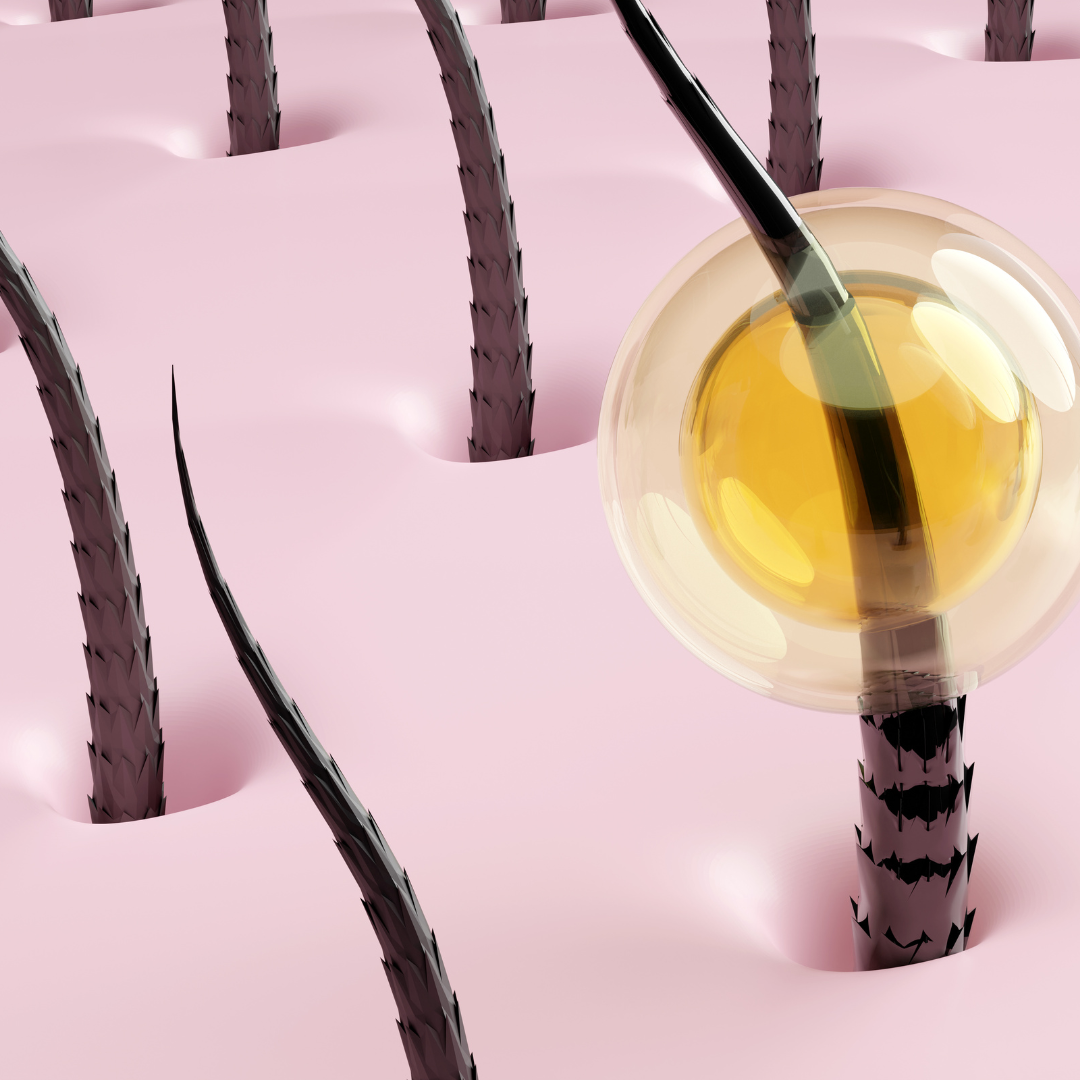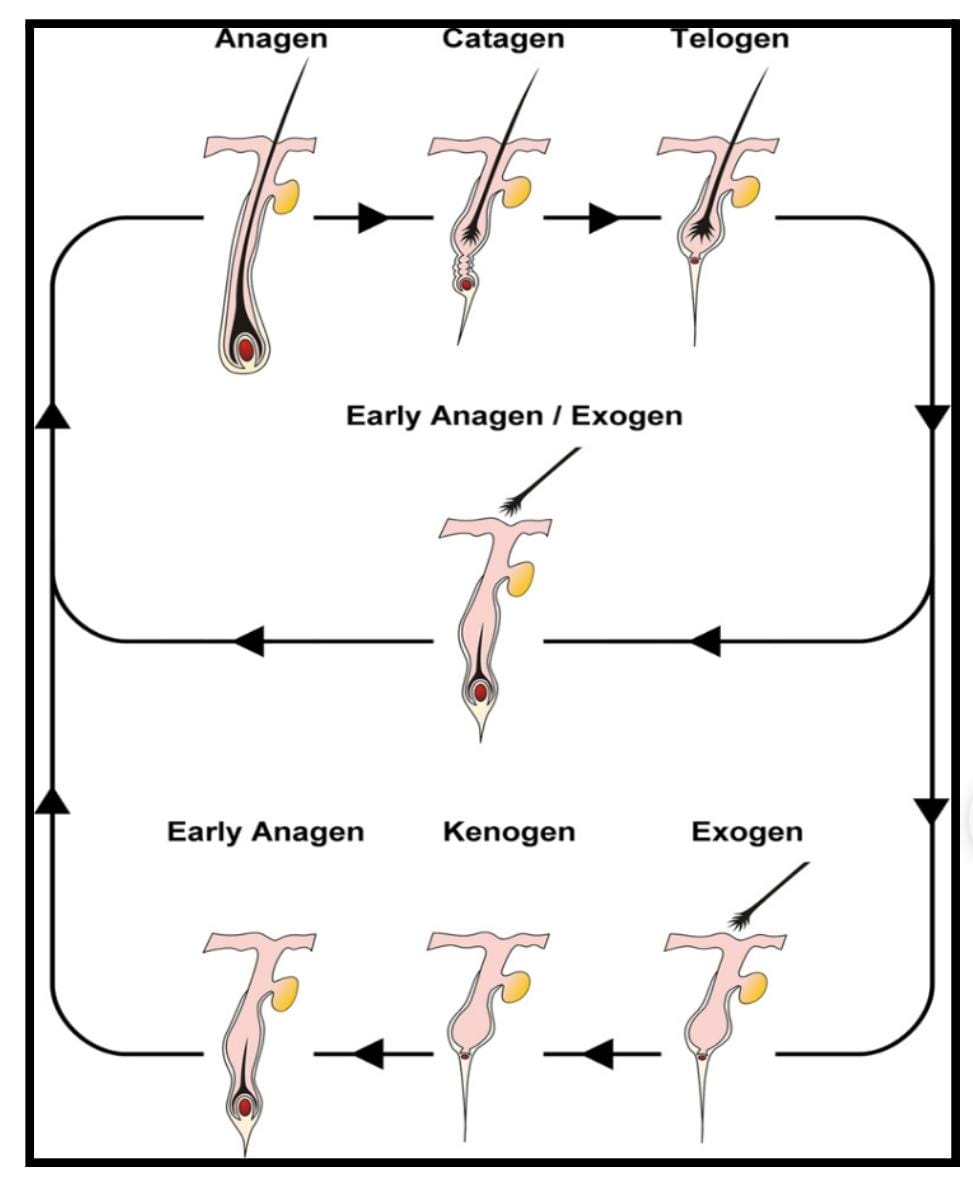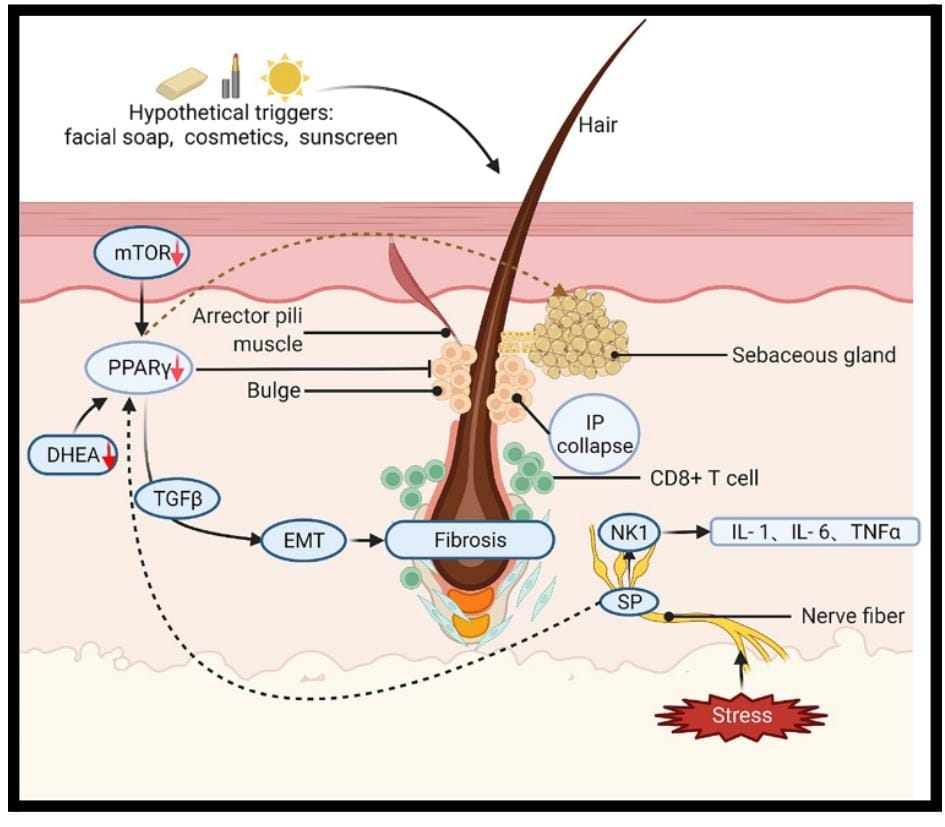Causal Mechanisms Behind Hair Follicle Disorders

Introduction
A hair disorder may possibly signify health risks, such as toxin-induced hair loss, hormonal imbalances brought on by tumours that secrete hormones, or severe inflammation like that caused by systemic lupus erythematosus.
Dermatologists have historically divided hair loss into categories based on different morphologies and reasons, such as androgen-mediated vs. non-androgen-mediated, inherited vs. acquired, scarring versus non-scarring, and inflammatory vs. non-inflammatory. (Skrok et al., 2015)

Epidemiology
Without therapy, hair loss affects a minimum of 45% of females by the age of 50 and 30-40% of males by the age of 35. Hair has a significant role in our appearance or social interaction. Therefore, it should come as no wonder that its absence can result in severe mental trauma among patients. (Chu et al., 2015)
What Is A Disordered Hair Follicle ?
A hair disease is a condition wherein the apparent hair exposure across the skin deviates from the typical range of hair development. The phrase "normal hair growth" has different meanings for different people depending on their gender, race, age, and frequently, their personal opinions. (Leung et al., 2013)
What are the Causes of a Disordered Hair Follicle ?
- Androgens over-stimulation, genetic predisposition, chronically oxidative stress, inflammation.
- Both internal and environmental causes like ultraviolet light, irritants and pollutants.
- Aging, mal nutrition.
- Facilitators of psychological and emotional stress (like cortisol and corticotropin hormone production).
- Increased production of pro-apoptotic and inflammatory cytokines.
- Generation of reactive oxygen species (ROS) all contribute to the disruption of immunological pathways that influence the follicle. (JDOnline, 2023).
A Cycle Of Hair Growth
However ethnicity can affect these numbers. In typical terminal scalp follicles, anagen may endure for two to six years, telogen for around three months, and catagen for about three weeks. Significant deviations from the typical hair cycle may perhaps result in a hair problem. (Leung et al., 2013).
The hair follicle phase comprises three primary phases: anagen, when a hair follicle is actively growing; catagen phase is when your hair follicle is regressing; and telogen happens when your hair follicle starts primarily dormant.
The kind of hair follicles involved and their location affect how long each stage takes. The percentage of scalp follicles that produce hair in anagen and telogen for someone who is considered to be "normal" is between 85% to 15%. (Skrok et al., 2015)

The Hair Follicle Physiology
All stages of hair development are controlled by endogenous regulators that promote alternately anagen (growth) or catagen (regression along with apoptosis), followed by telogen (rest), to ensure that, under normal conditions, shedding will be preceded by new growth.
Identification of the signals that regulate this is essential for thinking about therapies since early entrance into the period known as catagen is ultimately what causes hair loss. (Chu et al., 2015)
The dermal papilla cells (DPCs), which control the features of the follicle, release intermediaries that govern stem cells, and impact the formation of more follicular partitions, starting anagen growth.
A crucial signalling system controlling hair formation in anagen has been identified as the WNT pathway, which promotes the production of various anagen-stimulating substances like BFGF, IGF-1, and VEGF. (JDDonline, 2023)
Contrarily, catagen is thought to come from both a rise in the generation of pro-apoptotic cytokines counting TGF-b, IL-1, TNF-a as well as a reduction in the expression of proteins that maintain anagen.
Through endocrine gland paracrine, and autocrine pathways, the internal processes are also exposed using indicators via the macroenvironment (for example, hormonal and neurotransmitter release). For instance, androgens change the local immunological balance by causing the overexpression of paracrine mediators that limit growth and molecules that promote catagenicity, such as TGF-b, in the DPCs. (Skrok et al., 2015)
Additionally, in response to systemic and environmental stimuli, follicles, as well as nearby cells (such as adipocytes, keratinocytes, fibroblasts, and immune cells), produce mediators that change local signalling, generate ROS, and affect cycle regulation and growth. (Skrok et al., 2015)

Androgen Hormone Consequences
Androgens have been recognized to affect hair development for a very long time. In balding scalp follicles, androgen metabolism are increased in people with MPHL; however, this effect is much less pronounced in people with Female PHL, where the impact of androgen hormone is less clear. (JDDonline, 2023)
Density Of Hair Follicles
The overall shafts a person possesses in life is determined by embryogenesis, with the exception of circumstances where neogenesis can happen spontaneously in non-human species or experimentally induced or injury-mediated hair follicle development (neogenesis). Normally, there are 2 million follicles of hair on each human body. (Chu et al., 2015)
More frequently, a normal quantity of hair follicles grow, but are negatively damaged later throughout life by an insult, leading to decrease in hair follicles. It is obvious that the emergence of a hair problem may be caused by a significant alteration in the thickness on hair follicles when measured per area unit of skin. (Leung et al., 2013)
Size Of A Hair Follicle
Adults' hair follicles are divided into three types based on three main characteristics, including size. The majority of our follicles for hair create short, fine, vellus hairs that lack color. In contrast, from birth, the follicles of the scalp, eyelashes, and eyebrows produce significantly larger, slowly cycling, often colored terminal hairs.
Regarding the kind of hair generated, follicles still have some flexibility; they can go from producing vellus hair to producing terminal hair and vice versa. (Skrok et al., 2015)
The dimension of the hair follicles and the shape of the fibres they generate may have a significant influence on the amount of hair present. Conversely, hirsutism and hypertichosis are characterised by a vellus hair to terminating hair follicle transition. (Chu et al., 2015)
Growth Of Hair Fibers
Conclusion
The pace of hair development, as measured in the dermatological clinic, contributes little to overall hair covering when compared to follicle size and density.
Finasteride and minoxidil are the only two hair loss medications currently authorized by the FDA; however today only minoxidil products are commercially available in the market for FPHL as 2% and 5% solutions.
Finasteride, which prevents the formation of dihydrotestosterone (DHT), is an example of how this viewpoint researched medications that solely affects certain systems. The rate of growth of hair is rarely a serious problem unless the patient is impatient.
References
https://karger.com/spp/article/28/4/213/295745/The-Effect-of-Parathyroid-Hormones-on-Hair
Chu, T., Santos, L., & McElwee, K. (2015). Biology of the hair follicle and mechanisms of nonscarring and scarring alopecia. Seminars in Cutaneous Medicine and Surgery, 34(Chu et al., 2015), 50–56. https://shorturl.at/bsFT9
Breitkopf, T., Leung, G., Yu, M., Wang, E., & McElwee, K. J. (2013). The basic science of hair biology: what are the causal mechanisms for the disordered hair follicle? Dermatologic Clinics, 31(Skrok et al., 2015), 1–19. https://pubmed.ncbi.nlm.nih.gov/23159172/
Sadick, N. S., Callender, V. D., Kircik, L. H., & Kogan, S. (2017). New Insight Into the Pathophysiology of Hair Loss Trigger a Paradigm Shift in the Treatment Approach. Journal of drugs in dermatology : JDD, 16(11), s135–s140. Retrieved from: https://jddonline.com/articles/new-insight-into-the-pathophysiology-of-hair-loss-trigger-a-paradigm-shift-in-the-treatment-approach-S1545961617S0135X/?_page=4

Company
Need Help?
Recruitment
Made in Europe ©2024 Skillmed

